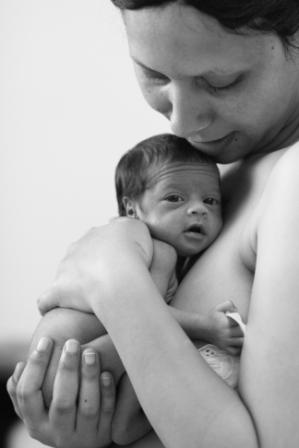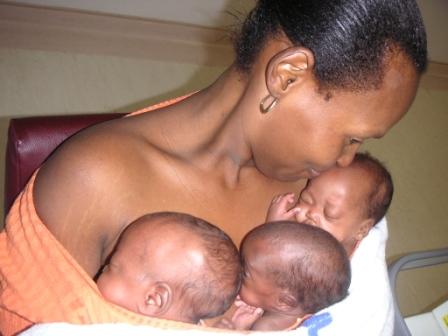Kangaroo mother care (KMC) reduces the risk of mortality in stable low birth weight infants.



Photos by: Louise Goosen, IBCLC (Mowbray Maternity Hospital, Cape Town)
![]()
![]()
![]()
Why is Kangaroo Mother Care important?
- Low birthweight (LBW) is a major contributor to neonatal and infant mortality. Conventional, or modern, neonatal care of LBW infants is expensive and requires highly skilled personnel. Kangaroo mother care (KMC) is an alternative to conventional care and is associated with a decreased risk of mortality and severe infection/sepsis. The major component of KMC is skin-to-skin contact between a newborn and mother, father, or other caregiver.
Does KMC work?
- KMC is associated with a reduced risk of mortality, hospital-acquired infection/sepsis at discharge and follow up.
- KMC increased some measures of infant growth, and mother-infant attachment and KMC mothers had higher rates of breastfeeding.
Equity: Does KMC work in the disadvantaged?
- A subgroup analysis found that mortality among infants who received KMC in low- and middle-income countries was about 1.5 times lower (RR 0.67, 95% CI 0.48-0.95).
Intervention Delivery
- All of the interventions included skin-to-skin contact and encouraged breastfeeding and the studies were conducted in a variety of hospital conditions, regulations, and routines and were compared to standard care (incubator only).
- The mean or median duration of KMC per day was <2 hours in six studies, 4-7 hours in three studies, 8-17 hours in seven studies, and ≥20 hours in three studies. When KMC was intermittent, it was substituted with radiant warmer/incubators.
- The benefits of KMC on mortality were not demonstrated when KMC was intermittent or initiated after 10 days post-birth.
Population and Setting
- Included studies were conducted in 12 countries: Australia, Colombia, Ecuador, Ethiopia, India, Indonesia, Madagascar, Malaysia, Mexico, Nepal, United Kingdom, and United States.
- Sixteen out of twenty-one included studies were conducted in low or middle-income countries.
Summary of Findings [SOF] Table: Kangaroo mother care for reducing morbidity and mortality in low birthweight infants
Patient or population: Infants with low birthweight
Settings: Neonatal intensive care unit/newborn nursery/home
Intervention: Kangaroo mother care
Comparison: Conventional neonatal care
| Outcomes | Anticipated absolute effects (95% CI) | Relative effect | No of Participants | Quality of the evidence | |
| Conventional neonatal care | Kangaroo mother care | ||||
|
|
|
|
|
|
|
| Mortality at latest follow-up | 60 per 1000 | 20 fewer per 1000 (from 3-31 fewer) | RR 0.67 (0.48-0.95) | 2293 (12) | Moderate1 |
| Severe infection/sepsis at latest follow-up-stabilized infants | 131 per 1000 | 66 fewer per 1000 (from 41-84 fewer) | RR 0.50 (0.36-0.69) | 1463 (8) | Moderate1 |
| Hypothermia at dischange or at 40-41 weeks' postmenstrual age-stabilized infants | 271 per 1000 | 195 fewer per 1000 (from 138-228 fewer) | RR 0.28 (0.16-0.49) | 989 (9) | Moderate2 |
| Weight gain at latest follow-up (g/d) - stabilized infants | 4.08 higher (2.30-5.86 higher) | 1198 (11) | Moderate3 | ||
| Any breastfeeding at discharge or at 40-41 weeks' postmenstrual age - stabilized infants | 762 per 1000 | 152 more per 1000 (from 53-238 more) | RR 1.20 (1.07-1.34) | 1696 (10) | Moderate4 |
| Any breastfeeding at 1 to 3 months' follow-up - stabilized infants | 711 per 1000 | 121 more per 1000 (from 36-221 more) | RR 1.17 (1.05-1.31) | 1394 (9) | Low1, 5 |
| Griffeth quotient for psychomotor developement (all subscales) at 12 months' corrected age (copy) | 1.05 higher (from 0.75 lower to 2.85 higher) | 579 (1) | Low6, 7 | ||
| About quality of evidence (GRADE) | |||||
1. Most of the pooled effect provided by studies with moderate or high risk of bias
2. Substantial heterogeneity (I2=52%)
3. Substantial heterogeneity (I2=86%)
4. Substantial heterogeneity (I2=80%)
5. Substantial heterogeneity (I2=62%)
6. Effect provided by 1 study with moderate risk of bias
7. Wide 95% confidence interval
Relevance of the review for disadvantaged communities | |
| Findings | Interpretation |
| Equity – Which of the PROGRESS groups examined |
|
| Sixteen of the included studies were conducted in hospitals in low or middle-income countries, while the other six were conducted in high-income countries. The mean or median age of the infants varied from 10 hours to 32 days at enrollment. The review did not report on the sex or gender of participants. All infants were stabilized LBW. | KMC is effective for LBW infants in low-resource settings. All of the included studies were conducted in hospitals but the findings may be applicable to mothers/caregivers and infants outside of hospital settings. It is not clear if KMC is safe for unstabilized LBW infants. The benefits for non-LBW infants have not been explored. |
| Equity Applicability |
|
| Included trials were conducted in a variety of hospital conditions and regulations, but the KMC intervention was consistent and included skin-to-skin contact and breastfeeding encouragement.
| KMC is feasible for high coverage implementation in low-income areas. This intervention can be applied in a variety of settings, including those which are resource-limited. |
| The included studies did not examine the effect of KMC on infants with congenital malformations or severe perinatal complications. | The effects of KMC on unstabilized LBW infants or those with congenital malformations or severe perinatal complications may need to be explored in other studies. |
| Cost-equity |
|
| None of the included studies reported on the cost of KMC compared to conventional neonatal care (incubator). One study reported that the cost for KMC was about 50% less than conventional care and the other reported that the cost of hospital stay and post-neonatal care at five months was US$741 less for the KMC group. | KMC is more cost effective than conventional neonatal care. Information on the total resource implications of the intervention is not available. Further should examine the cost effectiveness of KMC. |
| Monitoring & Evaluation for PROGRESS Groups |
|
| There is sufficient evidence to support the use of KMC in stabilized LBW infants as an alternative to conventional neonatal care in resource-limited settings. | KMC is effective to reduce mortality in stabilized LBW infants in low and middle-income countries. Interventions should include a mechanism to monitor the effectiveness of the intervention and cost-effectiveness. |
Comments on this summary? Please contact Jennifer Petkovic.
Drafted by Chaeyon Lee
